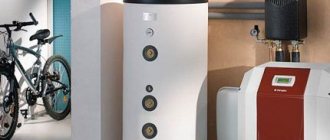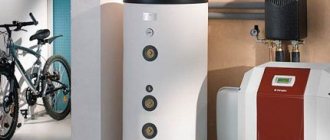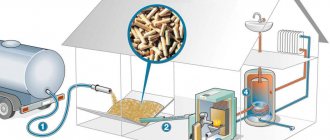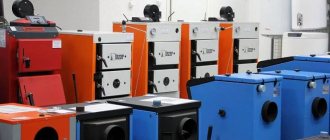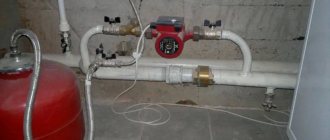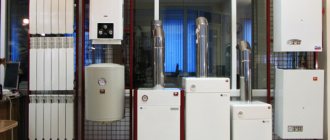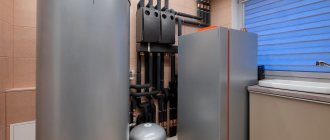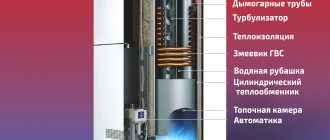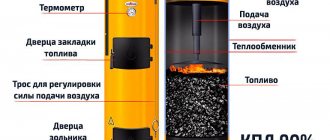Properly choosing boilers for heating a private home is necessary for installing an autonomous system. It is heating equipment that will provide housing with heat and hot water. It will create the microclimate necessary for human habitation. In addition, it will work flawlessly. It is so?
We will tell you how to buy a boiler that will meet your requirements and wishes. We have analyzed all the criteria that you should pay attention to when looking through catalogs of online stores or an assortment of specialized retail outlets. Problems that you may encounter before and after purchase are listed.
Basic criteria for choosing boilers
Hundreds of foreign and domestic manufacturers offer thousands of models of heating equipment. It is not easy for an unprepared buyer to navigate all this variety of products. I want it to be cheaper and the quality to be high.
All heating boilers differ in the type of fuel and are divided into the following categories:
- solid fuel (processing firewood, peat, pellets, coal);
- liquid fuel (units running on diesel fuel);
- gas (regular and condensing);
- electrical (requiring electricity supply);
- universal (using either gas or electricity).
Before choosing an option, it would be a good idea to do a little analysis and find out which energy carrier is profitable to use in your region. Then you need to decide how safe, reliable and comfortable the boiler should be in terms of every penny invested in it.
You need to choose one or another type of heating equipment after first familiarizing yourself with the advantages and disadvantages of each of them.
In order not to make a mistake and not waste your hard-earned money, you need to carefully consider the process of choosing equipment. To do this, it is necessary to take into account a number of nuances that significantly affect the final result.
When choosing a boiler you should:
- understand in detail the advantages and disadvantages of each type of boiler;
- calculate the optimal heating power for your home;
- decide on the number of circuits;
- choose the location where the equipment will subsequently be placed.
The maximum permissible dimensions and weight depend on the future location of the boiler. After all, for a small room it is not advisable to choose a heavy cast iron unit.
The choice of heating equipment must be approached responsibly. This is the only way to buy high-quality equipment that will last for many years.
Manufacturer country
Which wall-mounted gas boiler is better - Korean or European? It is between them that the struggle most often occurs in this segment.
Mistake #7
Korean boilers are more economical than European ones.
Mistake #8
European boilers are more economical than Korean ones.
All wall-mounted turbocharged boilers work approximately the same. Yes, their filling is different, but this does not affect the SAVINGS.
The efficiency of both Korean and European models is the same. Here you need to look at another parameter, namely, the availability in your city of a service for maintenance and repair of a specific brand.
Because sooner or later your boiler, no matter how reliable it is, WILL BREAK.
Based on this factor, it is worth making a choice in one direction or another. Remember a simple rule - the further you live from the service, the simpler the units you choose.
Rules for calculating equipment power
It’s worth remembering right away that the desire to save money on designing a heating system and performing thermal calculations in most cases backfires on the customer. If you think through everything carefully and trust a highly qualified specialist, then the cost of the boiler, radiators and other equipment will be much cheaper.
The power of the heating boiler is selected to calculate the distribution of approximately 0.1 kW per m2 of living space
To approximate the power of heating equipment required to heat a building and provide hot water supply, you can use special design standards.
It is also imperative to take into account:
- the number of people who will live in the house;
- building materials used for housing construction;
- climate zone;
- number of windows and doors;
- number of floors and other factors.
The opinion that the boiler power is selected at the rate of 0.1 kW per square meter is quite common. But thanks to modern building materials and innovative engineering equipment, heat losses can be significantly lower and, accordingly, the performance of heating equipment can be higher.
Comparison of fuel costs and operating costs
According to surveys and practice, the top three most important selection criteria for most buyers include gas consumption. For gas, some liquid fuel and solid fuel boilers, the maximum flow rate is indicated in the characteristics. But besides the fact that this is just the maximum possible indicator, it is difficult to deduce from it the degree of boiler efficiency, because fuel consumption also depends on the parameters of the house, correctly selected power, operating conditions of the boiler, etc.
In general, it is impossible to calculate the actual consumption of any type of fuel in a generalized form. However, approximately - quite realistic. The difference between heating costs is noticeable, which makes the picture clearer.
Natural gas . The normal calorific value of natural gas is 9.3-10 kW per m3 (the minimum allowable by GOST 5542-2014 is 8.84 kW/m3), this means that for 1 kW of thermal power of a gas boiler you need 0.1-0.108 m3 of natural gas gas For the 1st half of 2022, 1 m3 of main gas in the Moscow region is 5.92 rubles/m3 or 0.59-0.64 rubles. for each kW of boiler thermal power.
The generally accepted norm for an average uninsulated or weakly insulated house with a ceiling height of 2.7 m is: 1 kW for every 10 m2 of heated area.
The technical characteristics of any gas boiler indicate the maximum gas consumption, from here you can calculate the maximum possible heating bill. Using the example of BAXI SLIM 1.150 i (power 14.9 kW), the maximum natural gas consumption is 1.74 m3/hour:
- Per day – 24 (hours) * 1.74 (m3/hour) = 41.76 m3. In value terms – 41.76 (m3) * 5.92 (tariff for Moscow region, rub.) = 247.2 rubles/day.
- Per month – 30 (days) * 41.76 (daily consumption, m3) = 1,252.8 m3. In value terms – 1,252.8 (cubic meters) * 5.92 (tariff, rub.) = 7,416.6 rub./month.
- For the heating season (suppose from October 15 to March 31) - 136 (days) * 41.76 (m3) = 5,679.4 cubic meters. In value terms – 5,679.4 * 5.92 = 33,621.8 rubles/season.
It is important to understand that in practice the boiler does not operate 24/7 at full capacity: in this case, the wear of its elements accelerates many times over. A gas boiler correctly selected in terms of power (taking into account the area, heat loss of the house and a small power reserve of 10-20%) consumes only 50-70% of the values calculated above for the maximum possible operating mode of the boiler. Consider how many kW is needed specifically for your home.
How to calculate how much gas a gas boiler consumes All calculation methods and online calculator
Electricity . With electricity, calculations are much simpler: the efficiency of all modern electric boilers is 99%, that is, at maximum heating output, a 15 kW boiler unit will consume 15.15 kW of electricity. For the 1st half of 2022, 1 kW of electricity for a private house in the Moscow region costs 4.01 rubles. or 4.05 rub. for each kW of boiler thermal power.
The maximum possible heating bill using the example of any modern 15 kW electric boiler:
- Per day – 24 (hours) * 15.15 (kW) = 363.6 kW. In value terms – 363.6 (kW) * 4.01 (rubles per 1 kWh) = 1,458 rubles/day.
- 30 (days) * 363.6 (kW) = 10,908 kW per month In value terms – 43,741 rubles/month.
- For the heating season (suppose from October 15 to March 31) - 136 (days) * 363.6 (kW) = 49,449.6 kW. In value terms – 198,292.9 rubles/season.
Let us remind you that this is the maximum possible, and not the actual consumption.
How to calculate how much electricity an electric boiler consumes Calculation based on house parameters, examples of electricity bills
Firewood . The calorific value of ordinary freshly cut or recently cut firewood, the humidity of which is w ≈ 60–50%, is on average 1,800–2,000 kW/m3. This means that to obtain 1 kW of thermal energy, 0.0005-0.00056 m3 of firewood is needed. The cost of 1 cubic meter of freshly cut birch, alder or oak firewood is 1,600-1,800 rubles. or 0.8-1.01 rub. for each kW of boiler thermal power.
Coal . The calorific value of the most common coal is (w ≈ 7–15%), on average 7.5-8 kW/kg. This means that to obtain 1 kW of thermal energy, 0.133-0.125 kg of coal is needed. The cost of 1 ton of coal is 6,000 rubles. or 0.75-0.8 rub. for each kW of boiler thermal power.
Of course, it would be correct to make an adjustment for the efficiency of solid fuel boilers, which is on average 80%. For a more realistic picture, it is advisable to multiply the obtained cost indicators for 1 kW by 1.2 (80% efficiency).
Diesel fuel and fuel oil. Without going into details, liquid fuel boilers, when burning 1 liter of diesel fuel, waste oil or fuel oil, produce 10 kW of thermal energy. That is, 1 kW of thermal power accounts for 0.1 liters of fuel. The cost of Euro 4 diesel fuel is 35-40 rubles/l or 3.5-4 rubles. for each kW of thermal power. The cost of used oil in Moscow Region is on average 8-15 rubles/l or 0.8-1.5 rubles for each kW of thermal power.
Maximum consumption of a diesel boiler (l) – Boiler power, kW / 10, hence, having a 15 kW boiler:
- Per day – 24 (hours) * 1 (l) = 24 l. In value terms – 24 (l) * 35 (rubles per 1 l) = 840 rubles/day.
- Per month – 30 (days) * 24 (l) = 720 l. In value terms – 25,200 rubles/month.
- For the heating season (suppose from October 15 to March 31) - 136 (days) * 24 (l) = 3,264 l. In value terms – 114,240 rubles/season.
It is important to understand that these figures are given for continuous operation at full power, which is quite rare. Typically, boilers operate no more than 1/3 of the time of day, so these calculations can be safely reduced by 2-3 times. Also, liquid fuel boilers are usually purchased if there is a source for purchasing fuel at lower than average market prices.
| Type of fuel | Calorific value, kW.h/m3 (kg, t, l) | Cost of fuel unit, rub. | Cost of 1 kW of thermal energy, rub. |
| Natural gas | 9,3-10 | 5,92 | 0,59-0,64 |
| Electricity | 1 | 4,01 | 4,05 |
| Firewood | 1 800-2 000 | 1 600 | 0,8-1,01 |
| Coal | 7,5-8 | 6 000 | 0,75-0,8 |
| Diesel fuel | 11-11,3 | 35 | 3,5-4,0 |
| Working off | 11-11,3 | 8 | 0,8-1,5 |
Features of single- and double-circuit boilers
When thinking about how to choose the right heating boiler for your home, special attention should be paid to such a characteristic as the number of circuits. Single-circuit technology is intended exclusively for heating the coolant circulating through heating pipes.
A single-circuit boiler is designed to serve only one system: either hot water supply or heating. If it is not possible to install a double-circuit unit, it is permissible to use no more than two boilers in one boiler room, regardless of their floor or wall-mounted design
In this case, to heat tap water you will have to additionally install a boiler. Yes, a single-circuit boiler is convenient, but the disadvantage of this solution is its high cost - you will have to buy not only heating equipment, but also a boiler. Moreover, both devices will take up a lot of space.
As for the double-circuit boiler, here the heating equipment and water heater are assembled into a single structure. Thanks to this structure, you can solve two problems at once, while purchasing only one unit.
In addition, in the absence of hot water, the coolant can be redirected to the second circuit and used alternately - to heat the house and to provide hot water supply.
Operating principle of single-circuit equipment
Single-circuit heating equipment is most often used by owners of luxury country houses. In essence, a single-circuit boiler is the same water heater, but supplies water to the heating system.
The operating principle of this type of equipment is based on burning fuel in a special compartment and heating the liquid. The heating main is connected to the outlet where the hot coolant enters. Next, the water begins to circulate through the pipes and heat the rooms.
The final stage of circulation is the flow of waste coolant back into the boiler through the inlet pipeline.
If you do not need to provide hot water supply, then it is better to give preference to single-circuit boilers
The cost of a single-circuit boiler may be more than a double-circuit system. Even despite less functionality, this type of equipment is less expensive to install, easier to operate and more energy efficient.
Single-circuit equipment is suitable for those buyers who want to spend money once and buy reliable equipment that does not require special care. This type of boiler will be the ideal and only right choice when there is no need for hot water supply in the house.
Design specifics of a dual-circuit unit
A double-circuit boiler is a system where, in addition to the primary heat exchanger, there is an additional one designed to heat water and then supply it to the water supply system. The movement of the coolant is controlled using a three-way valve. It directs the heated water either to the DHW circuit or to the heating system.
It should be noted that in the first case, the coolant will be supplied only if the hot water tap has been opened. The peculiarity of such heating equipment is that while the tap responsible for supplying hot water is open, the system does not work.
If you have a large family and some of its members like to take long showers, then the rooms may become cool. Manufacturers solve this problem by installing a storage water heater in their boilers.
The disadvantages of the double-circuit boiler design include the need for careful and attentive maintenance. This is due to the fact that the secondary heat exchanger can become overgrown due to the use of water containing organic and mineral particles suspended in it, and the small diameter of the pipes.
If you plan to actively consume hot water, then installing a double-circuit boiler is not the best solution. After all, then the house will not be heated well. You should only think about installing this system in a small house or apartment, where there is not enough space to organize a full-fledged boiler room.
Floor or wall?
Mistake #17
There is no clear answer which is better.
In the vastness of our country, it is still believed that floor-mounted ones outperform wall-mounted ones.
At the same time, in Europe they have long been recognized as low-energy efficient devices and are practically banned in all residential buildings.
It's only the beginning
